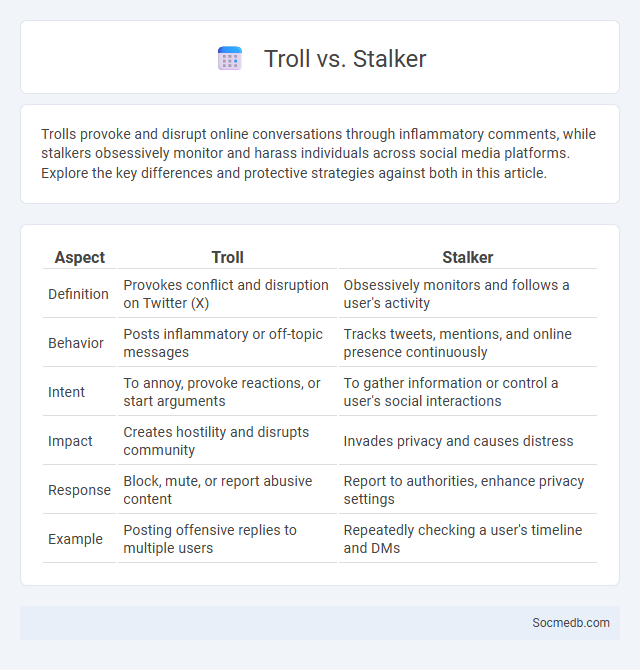
Photo illustration: Troll vs Stalker
Trolls provoke and disrupt online conversations through inflammatory comments, while stalkers obsessively monitor and harass individuals across social media platforms. Explore the key differences and protective strategies against both in this article.
Table of Comparison
| Aspect | Troll | Stalker |
|---|---|---|
| Definition | Provokes conflict and disruption on Twitter (X) | Obsessively monitors and follows a user's activity |
| Behavior | Posts inflammatory or off-topic messages | Tracks tweets, mentions, and online presence continuously |
| Intent | To annoy, provoke reactions, or start arguments | To gather information or control a user's social interactions |
| Impact | Creates hostility and disrupts community | Invades privacy and causes distress |
| Response | Block, mute, or report abusive content | Report to authorities, enhance privacy settings |
| Example | Posting offensive replies to multiple users | Repeatedly checking a user's timeline and DMs |
Understanding the Terms: Troll, Stalker, and Their Differences
Trolls are individuals who deliberately provoke and disrupt online conversations by posting inflammatory or off-topic messages, while stalkers engage in persistent and unwanted monitoring or harassment of a person across social media platforms. Understanding these distinctions helps you recognize harmful behavior patterns, protecting your online presence and mental well-being. Identifying a troll's intent to incite conflict versus a stalker's obsession with surveillance is crucial for applying appropriate privacy settings and reporting mechanisms.
Origins and Evolution of Internet Trolls
Internet trolls originated in the early days of online forums and chat rooms during the late 1990s, where users deliberately provoked others to elicit emotional responses or disrupt conversations. The evolution of trolls coincided with the exponential growth of social media platforms such as Twitter, Facebook, and Reddit, which amplified their reach and impact. Over time, trolling tactics have become more sophisticated, ranging from simple baiting to coordinated disinformation campaigns targeting individuals, groups, and institutions.
What Defines a Stalker in the Digital Age?
A stalker in the digital age is defined by persistent and unwanted monitoring or harassment through social media platforms, including constant messages, tracking online activities, and invading privacy without consent. This behavior often involves using technological tools to gather personal information, create fake profiles, and manipulate digital presence to intimidate or control the victim. Legal frameworks increasingly recognize these actions under cyberstalking, highlighting the importance of digital boundaries and security measures.
Troll Characteristics: Motivations and Behaviors
Trolls on social media often exhibit behaviors driven by motivations such as seeking attention, disrupting conversations, or expressing frustration. They employ tactics like inflammatory comments, spreading misinformation, and personal attacks to provoke emotional reactions from users. Understanding these characteristics helps in developing effective moderation strategies to maintain healthy online communities.
Stalker Tactics: Online and Offline Manifestations
Stalker tactics manifest both online and offline, exploiting social media platforms to track and monitor victims' activities, personal information, and social connections. Perpetrators frequently use features like location sharing, direct messaging, and social network feeds to gather data and exert control or intimidation. Offline manifestations include physical surveillance and unwanted encounters, which often escalate from digital harassment, emphasizing the critical need for robust privacy settings and awareness on social channels.
Comparing Trolls and Stalkers: Key Similarities and Differences
Trolls and stalkers both disrupt online spaces through unwanted interactions, but trolls primarily seek attention and provoke reactions with inflammatory comments, while stalkers focus on persistent, invasive monitoring of Your personal life, often crossing legal boundaries. Trolls operate openly on social media platforms targeting public discourse, whereas stalkers engage covertly, causing emotional distress through obsessive behaviors. Understanding these key differences helps You navigate social media safety and privacy concerns effectively.
The Impact of Trolls vs. Stalkers on Victims
Trolls on social media platforms primarily disrupt public conversations through provocative or inflammatory comments, causing emotional distress and reputational damage to victims. Stalkers, however, employ persistent, targeted harassment that invades personal privacy, leading to heightened fear, anxiety, and potential real-world safety risks. The psychological impact of stalking is often more severe and long-lasting than trolling due to its intrusive, relentless nature and direct threat to personal security.
Legal and Ethical Perspectives: Addressing Trolls and Stalkers
Legal frameworks impose strict penalties on social media trolls and stalkers to protect users' privacy and mental well-being. Ethical guidelines emphasize respectful online behavior, encouraging users to report abusive content promptly to maintain a safe digital space. Your proactive engagement in recognizing and addressing harmful interactions reinforces collective accountability and digital safety.
Prevention and Protection: How to Deal With Trolls and Stalkers
Maintaining your online safety involves implementing strong privacy settings and carefully managing who can access your personal information on social media platforms. Recognize the signs of trolls and stalkers early, such as repeated unwanted messages or suspicious behavior, and utilize blocking and reporting tools to limit their access. Empowering Your digital presence with these prevention measures reduces the risk of harassment and protects your mental well-being.
Social Media’s Role in Empowering Trolls and Stalkers
Social media platforms provide trolls and stalkers with unprecedented access to potential targets, amplifying harassment through anonymity and ease of content sharing. Algorithms designed to maximize engagement often inadvertently promote inflammatory content, enabling harmful behaviors to persist and escalate. These dynamics challenge online safety efforts, necessitating stronger platform policies and advanced moderation technologies to protect users effectively.
 socmedb.com
socmedb.com